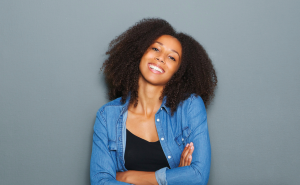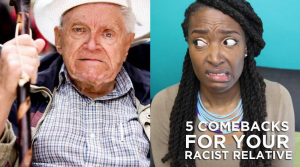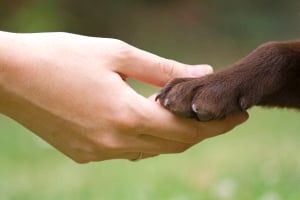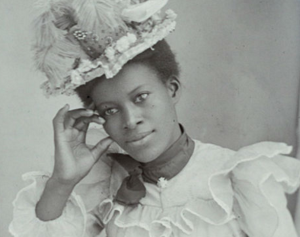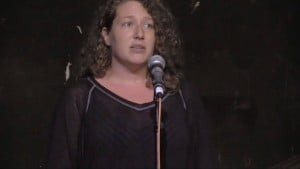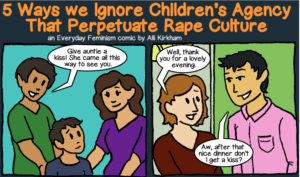In May of 2014, I found myself shopping online for something I never thought I would go back to once I left them behind in middle school: thin bralettes and triangle bras.
I had just finished reading a blog post about a possible link between the prolonged wear of underwire bras and breast cancer, and before I even finished reading it, I knew I wanted to buy new bras.
I wasn’t entirely convinced that underwire bras could be connected to breast cancer, but this new concern was simply more fodder for my growing aversion to underwire bras. As a cisgender woman who eventually grew to be an average C-cup, I’ve been wearing bras for years now. I remember the discomfort of my first bras, the years of struggling with ill-fitting bra after ill-fitting bra, and then the relative relief of finally finding a “good fit.”
But even a “good fit” was uncomfortable for me. For reasons that I’ll put down to growing weariness of repeatedly wearing a harness around my chest for years (and the actual dents in my shoulders that came with that), I’d found myself ditching bras more frequently when I was at home.
The feeling of slipping out of a bra after a long day (or better, never putting one on for a weekend in) felt more and more rewarding every time I did it. In comparison, the feeling of putting on an underwire bra felt increasingly restrictive.
I was always uncomfortable in underwire bras, but I’d gotten so used to the pain and discomfort that I just accepted it as the struggle that came with being a woman with breasts.
So when I read this blog post that mentioned an alternative of wearing looser triangle bras and bralettes, I decided to give them a try – and bought five new bralettes and triangle bras within the month. I wanted to feel comfortable again.
That was over a year and some months ago. As the new bras I wore began to challenge the way I felt about my breasts and my body, I realized several important things, all centered around one main revelation: I’d spent years being ashamed of my breasts.
This shame was based on how heavily women’s bodies – especially our breasts, if we have them – are sexualized in the United States. My shame had become so habitual and second nature that I hardly even noticed it.
So over this past year, I’ve challenged myself to push the boundaries of my own comfort and have unintentionally, but thankfully, began unpacking the years of shame that began when my breasts started developing in fourth grade.
Admittedly, it hasn’t been a smooth and complete process.
I felt self-conscious months after wearing my new bras, and I still occasionally do. The moments in which I pushed back against my own emotional discomfort were often motivated by anger, frustration, and sometimes even laziness.
I understand that I’ve been lucky to explore and challenge social norms in ways that other women can’t. As a cisgender woman, even through my discomfort, I’ve been privileged to have a body that has always matched the gender I identify as and have experienced my breasts in a less complicated way than trans and gender non-conforming folks do. I also wasn’t pushed into trying new bras because of serious concern or affliction of breast cancer. And yet, for other women with similar positionality who have experienced breast shame, I think it’s important to discuss.
Many larger breasted women face more constant sexualization than I ever have, and there are many women who suffer from back problems and require more support who feel that thin bras and bralettes may not be realistic options.
Even so, I encourage women to examine their breasts outside of the sexualized nature that American society has convinced us is their primary purpose.
I’m still at the beginning of the process, but here’s what I’ve learned – or unlearned – so far.
1. Nipples Aren’t Disgusting or Offensive
Before I purchased my new bras, I had one major concern about them: people seeing the outline of my nipples through their thin fabric.
Years ago, while browsing in a department store’s undergarment section, I witnessed an interaction between an older woman and a saleswoman. The older lady lowered her voice to tell the saleswoman that she needed a bra with solid coverage. She said she didn’t like it when her nipples showed when it was cold.
“I don’t like that either,” the saleswoman said, and she led the older woman away to help her find a bra that would keep her “decent.”
Everything about that interaction spoke of shame – and worse, shared shame.
The lowered voice and the avoidance of the word “nipples” were a testament to how we’ve come to view something perfectly normal as something shameful.
Unfortunately, at that time, I didn’t think of it this way. Teenaged me only took this as a reassurance that my own similar embarrassment and shame was just another part of being a woman with breasts.
I don’t know what led those other two women to feel embarrassed about having just the outline of their nipples visible, but for me it was the unwanted attention my breasts received from men.
I’d been told that having breasts now meant I had to cover up my chest at all times. But I soon learned just how exposed one could feel under a man’s gaze.
After my breasts developed, I Increasingly caught men staring at my chest instead of looking at my face.
When something as basic and normal as cold nipples drew attention from lewd men, I felt that the attention was somehow my fault. I felt so responsible for this reaction that I couldn’t control that I soon began stocking my closet with a variety of cardigans that I would wear as often as possible. I couldn’t risk being indecent.
The United States has a weird relationship with the female nipple.
Men have been free to roam around topless and unashamed since 1936, but women are still embarrassed to even have it publicly acknowledged that we have nipples. It’s perfectly okay for our sexualized breasts to be plastered all over advertisements and in entertainment, but just the slightest suggestion of non-sexual areola is enough to get women kicked off social media platforms.
We’re so used to viewing breasts as inherently sexual (which, by the way, they aren’t) that we’re disturbed and disgusted by images of women breastfeeding, one of the natural purposes of breasts.
When I first began wearing my thin and unpadded bras, I still felt compelled to cover up in cold temperature with sweaters and cardigans. But over time, I stopped worrying about what my nipples were doing.
I knew I wasn’t sending out an invitation for attention or suggesting anything sexual – I was just cold. We’re not embarrassed by goose bumps when we’re cold, so there’s no reason for me to be embarrassed by cold nipples either.
If you feel uncomfortable about nipple outlines on women, you should think about your comfort levels and explore where they come from.
If seeing just the outline of another woman’s nipples bothers you, ask yourself why.
If a women breastfeeding seems disgusting to you, question why you feel that way about something breasts are naturally meant for.
Taking the time to address, question, and unpack reactions that we’ve taken for granted can help us identify the source of our discomfort.
From there, we can begin the work of learning to view our bodies without the burden of sexualization.
2. There’s Nothing Wrong with the Way Our Breasts Look Naturally
Before I began filling my closet with cardigans, I used other methods to try to hide my breasts.
My middle school wardrobe was made up almost entirely of large shirts that I would wear to try to hide my body. In an attempt to reduce the appearance of my breasts, I even developed a slouching posture that I’m still working to break the habit of today.
My breasts weren’t – and still aren’t – very large, but even then, I wanted them to appear smaller so that they would draw less unwanted attention.
Underwires and padded bras held my breasts up and together in a way that I always felt made them look bigger. So when I purchased my new bras, one of my ulterior motives was to make my breasts look smaller.
What I didn’t think about was how changing to looser bras that let my breasts hang more freely wouldn’t only make them appear smaller, but also less “perfect.”
As much as I’d internalized nipple shame, I’d also internalized the idea that my breasts were supposed to look a certain way: round, perky, evenly sized, and perfectly spaced apart.
Clothed or otherwise, we see women’s breasts everywhere. Sprawled across billboards, advertisements, in movies, and on tv, we’re often looking at breasts that have been manipulated so much that they resemble breasts that only a small percentage of women naturally have.
In reality, most people with breasts don’t have “perfect breasts.” Just like a majority of breasts out there, mine aren’t perfectly even or round. And my new bras seemed to make that more noticeable.
Occasionally, I found myself feeling uncomfortable and self-conscious, as if everyone was looking at me and wondering what the hell was wrong with my breasts.
But I also knew that those were feelings I needed to push back against. If I really wanted to feel comfortable in my body, I couldn’t continue to compare myself to the false advertisement of perfect breasts.
It helped me to explore projects such as Bare Reality, which celebrate the variety of shapes, textures, and sizes that natural breasts come in.
Women’s minds and bodies are repeatedly subjected to unrealistic expectations of how we should look.
When all you see are certain types of breasts, it’s inevitable to feel like our natural and perfectly normal breasts are imperfect.
Counteracting images of photo-manipulated breasts with reminders of what real breasts look like can help undo some of that thinking.
3. We Should Be the Ones Who Control How We Feel About Our Breasts
I used to stand in front of the mirror and simply want to disappear. For years, I could never quite understand why I felt that way, I just knew that I felt it.
It’s only recently, after challenging myself and reflecting on how I felt about my breasts, that I realize it was another manifestation of my shame.
I would get dressed, look in the mirror, and sometimes, no matter how covered up I was, would be overwhelmed by the feeling that nothing I wore would ever be enough to keep me from being “indecent.”
I would want to crawl back into bed and not face the world.
I couldn’t name it then, but I was struggling with the understanding that there was nothing I could do to prevent my body from being sexualized without my permission.
When you live in a society that has determined that your very body is inherently sexual, feeling helpless is understandable.
When teenage girls are being sent home from school because their bra straps might be distracting to male students or getting kicked out of prom because grown men are having “impure thoughts,” we’re telling them that female bodies are inherently sexual and that they should be ashamed of them.
Ironically, it was understanding this now that gave me the freedom to walk around more freely in my own body.
I know that my body isn’t inherently sexual, so I’m under no obligation to bend to the arbitrary rules of decency that have been set in place by a society that doesn’t understand that.
When I walk out of the house without a bra on because I just need to grab something from the store down the street, or I walk around in a cold building with goosebumps and visible nipple outlines, I’m not asking for any attention.
I’m simply existing.
And I’m not responsible for the thoughts of men who haven’t learned to respect my right to exist.
If your current bras are restricting you physically and/or mentally, know that you’re allowed to control what you wear and how you feel about your body. Experiment with alternative forms of breast coverage and undergarments.
I’m not advocating for going topless or even completely braless, but for discovering and establishing your own levels of comfort.
I put up with underwire bras because I accepted the discomfort as something that I must tolerate in order to be an “acceptable” and “decent” woman. I didn’t even notice my shame because I had quietly accepted the lie that my body was shameful.
When the rules of decency are arbitrarily controlled by a society that denies us autonomy over our own bodies, simply redefining your own level of acceptability can be freeing.
At 24, I’ve finally stopped feeling ashamed of my breasts.
My collection of cardigans now sits in the back of my closet, unworn for more than year. I’m as embarrassed about visible nipple outlines as I am about my goose bumps, which is to say, not at all. I can’t remember the last time I looked in the mirror and wanted to disappear.
I still catch myself slouching – bad posture has been harder for me to remedy than internalized shame, it seems. But the thing is, I catch it more. And I stand up straighter, head high, shoulders back, chest out.
[do_widget id=’text-101′]
Search our 3000+ articles!
Read our articles about:
Our online racial justice training
Used by hundreds of universities, non-profits, and businesses.
Click to learn more
Most Read Articles
- « Previous
- 1
- …
- 30
- 31
- 32


